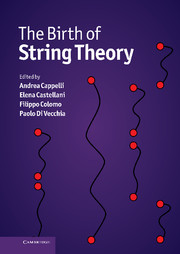Book contents
- Frontmatter
- Contents
- List of contributors
- Photographs of contributors
- Preface
- Abbreviations and acronyms
- Part I Overview
- 1 Introduction and synopsis
- 2 Rise and fall of the hadronic string
- 3 Gravity, unification, and the superstring
- 4 Early string theory as a challenging case study for philosophers
- EARLY STRING THEORY
- Part II The prehistory: the analytic S-matrix
- Part III The Dual Resonance Model
- Part IV The string
- TOWARDS MODERN STRING THEORY
- Part V Beyond the bosonic string
- Part VI The superstring
- Part VII Preparing the string renaissance
- Appendix A Theoretical tools of the Sixties
- Appendix B The Veneziano amplitude
- Appendix C From the string action to the Dual Resonance Model
- Appendix D World-sheet and target-space supersymmetry
- Appendix E The field theory limit
- Index
1 - Introduction and synopsis
from Part I - Overview
Published online by Cambridge University Press: 05 May 2012
- Frontmatter
- Contents
- List of contributors
- Photographs of contributors
- Preface
- Abbreviations and acronyms
- Part I Overview
- 1 Introduction and synopsis
- 2 Rise and fall of the hadronic string
- 3 Gravity, unification, and the superstring
- 4 Early string theory as a challenging case study for philosophers
- EARLY STRING THEORY
- Part II The prehistory: the analytic S-matrix
- Part III The Dual Resonance Model
- Part IV The string
- TOWARDS MODERN STRING THEORY
- Part V Beyond the bosonic string
- Part VI The superstring
- Part VII Preparing the string renaissance
- Appendix A Theoretical tools of the Sixties
- Appendix B The Veneziano amplitude
- Appendix C From the string action to the Dual Resonance Model
- Appendix D World-sheet and target-space supersymmetry
- Appendix E The field theory limit
- Index
Summary
String theory describes one-dimensional systems, like thin rubber bands, that move in spacetime in accordance with special relativity. These objects supersede pointlike particles as the elementary entities supporting microscopic phenomena and fundamental forces at high energy.
This simple idea has originated a wealth of other concepts and techniques, concerning symmetries, geometry, spacetimes and matter, that still continue to astonish and puzzle the experts in the field. The question ‘What is string theory?’ is still open today: indeed, the developments in the last fifteen years have shown that the theory also describes higher-dimensional extended objects like membranes, and, in some limits, it is equivalent to quantum field theories of point particles.
Another question which is also much debated outside the circle of experts is: ‘What is string theory good for?’ In its original formulation, the theory could not completely describe strong nuclear interactions; later, it was reproposed as a unified theory of all fundamental interactions including gravity, but it still needs experimental confirmation.
This book will not address these kinds of questions directly: its aim is to document what the theory was in the beginning, about forty years ago, and follow the threads connecting its development from 1968 to 1984. Over this period of time, the theory grew from a set of phenomenological rules into a consistent quantum mechanical theory, while the concepts, physical pictures and goals evolved and changed considerably.
- Type
- Chapter
- Information
- The Birth of String Theory , pp. 3 - 16Publisher: Cambridge University PressPrint publication year: 2012



